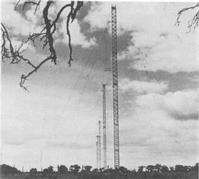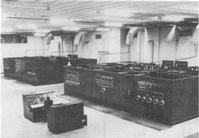


Chapter 8
I Part 1: Communications
i Before the Telegraph
ii Electrical Communication Before Federation
iii Federation to the End of the Second World War
iv Post-war and on to 1975
v 1975 ONWARDS
II Epilogue
III Part 2: Early Australian Computers And Computing
IV Acknowledgements
References
Index
Search
Help
Contact us

Federation to the End of the Second World War (continued)
With the outbreak of the Second World War, the manufacturing and research facilities and capabilities of the communications sector rapidly became important contributors to the total war effort. Domestic production by companies such as AWA, STC and Philips gave way to a wide range of defence related work on a greatly expanded basis, in addition to manufacturing communications items to replace those which had been imported previously. As examples of defence work, an extensive range of radio equipment was produced for the armed services, while radar equipment was developed and manufactured, as were items such as air speed indicators, altimeters and artificial horizons for the aircraft industry, which itself had to be developed from a very small base. On the civil side, high powered HF transmitters for Radio Australia were designed and constructed for installation at Shepparton.

The research Laboratories were also extensively involved in defence projects as well as in their basic responsibility for Australia's communication system. Projects ranged from communications in fighter aircraft, to deep sea diving suits, to the measurement of noise levels in Army tanks and the testing of parachute silk. The investigation of problems connected with the design of specialised equipment for the defence forces was an ongoing task throughout the war years, with a total of over 400 separate studies. The development and application of Radar was of major importance and the Laboratories were involved in a series of projects. An extensive range of studies was undertaken in the radio field, including the establishment of major radio sites at Werribee, where a large receiving station, with a complex of 31 antennas, was established.
Within the telecommunications system itself, the war years were what has been described as a time of 'make and mend'. Switching equipment, for example, had been entirely imported from the UK and this supply line was greatly reduced. In the early war years, the position was helped by some supply of Strowger equipment from North America, but Australian engineers had to manage largely with what they had, at a time when many new demands had to be met, as the defence forces grew rapidly and industry in general applied itself to the war effort. Little of the innovative work which was undertaken was documented and thus it is lost to history.
Contingency plans were developed against the possibility of damage from enemy action, including the establishment of a network of shadow exchanges in each of the capital cities, initially small manual exchanges located close to main cable routes but in inconspicuous locations. Later a limited number of transportable automatic exchanges were constructed and as the war moved further northward, these were brought into regular use at pressure points in the network, on the basis that they would be recovered in the case of an emergency. High priority lines were also identified and strategies developed for their early restoration in the case of network damage. The PMG Department also established, as a part of Civil Defence arrangements, a system of air raid warning sirens covering metropolitan areas, using PMG cable pairs, with the street lighting system controlled from the same central location.
Organisations in Australian Science at Work - Amalagamated Wireless Australia (A.W.A.); Philips Electrical Industries; Radio Australia; Standard Telephones and Cables (S.T.C.)
 |
Australian Academy of Technological Sciences and Engineering |  |
© 1988 Print Edition pages 555 - 558, Online Edition 2000
Published by Australian Science and Technology Heritage Centre, using the Web Academic Resource Publisher
http://www.austehc.unimelb.edu.au/tia/543.html